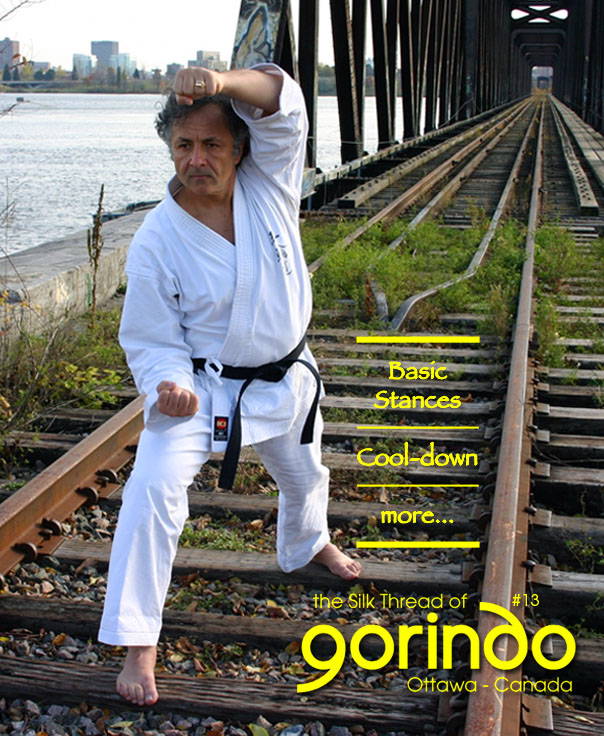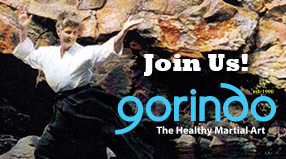
The Silk Thread of Gorindo - Ottawa - Canada
Issue 13
Photo cover Claudio Iedwab sensei, November 2011, by Roxanne Standefer
Basic Stances
Zenkutsu-dachi From parallel stance, heiko-dachi, move your right foot forward, drawing a slight concave arc to the outside. Center your body weight and move smoothly and silently without stepping hard on the floor. The step is the distance of a shin plus a foot distance. As you step, lower the hips and bend the front knee so the front shin is perpendicular to the ground and the knee slightly inside the plumb line from the heel. Always touch the ground first with the toes and metatarsal, and after with the heel. The forward foot is slightly pointing inside, with the outside edge straight in line with the direction of travel. The toes grip the ground. The rear leg is extended (without locking the knee joint), and the toes of the rear foot point outside at a 45° angle (outside edge of foot.) Check body position by placing your hands on your hips above the obi, belt, with your elbows pointing out and it will help you to better visualize the direction of your hips and shoulders. For zenkutsu-dachi, front stance, the hips and upper body generally face directly forward. Always maintain your back straight and perpendicular to the ground with the eyes looking ahead, not to the ground. The body weight is distributed 60% in the front leg and 40% to the rear. This stance is very stable to the forward and backward directions. Lowering the center of gravity also ensures that the power from driving with the rear foot and the springing of the knee, is effectively transmitted through the technique. Remember • Control your balance by remaining centered and low. When walking, move the feet in a concave arc to the outside, not in a straight line. Keep the knee of the support leg slightly bent so that you donot bob up and down. Also avoid touching one foot to the other; this will move your center of gravity from side to side and decrease your base of support. • Keep the sole of the feet on the ground for stability. For mobility, (once you can control your balance), focus more of your body weight in the toes and metatarsal area with the heels slightly off the ground (just the thickness of a piece of paper between the sole and the floor). • See ‘Some Advice About... Stances’ for general tips common to all stances. Common Corrections • Stance too short in length with weight back and too high. • Too much weight placed on the front foot, giving an apparently solid stance but losing stability and mobility. • Too much flexion of the front knee can produce injuries to the joint and ankle. • The forward foot pointing outside, will not work as a ‘brake’, or pointing too much inside can damage the ankle joint. • Rear foot pointing too far outside in 90° or backward, reducing the opportunity to rotate and control the hip motion. • Locking the rear leg knee joint. • Leaning the body forward, backward or to the side. • Placing one foot directly in line with the other, making the stance very narrow and unstable. by Claudio Iedwab & Roxanne Standefer Originallly published in the Gorindo Student Manual and “The Secret Art of Health & Fitness – Uncovered from the Martial Arts Masters” by Claudio Iedwab & Roxanne Standefer ©2011 Photo by Roxanne Standefer / Illustrations by Claudio Iedwab 
 Maintain both heels on the floor. If we draw two parallel lines along each foot, their distance apart is the same as the shoulders.
Maintain both heels on the floor. If we draw two parallel lines along each foot, their distance apart is the same as the shoulders.
« Click the Subscribe link on the left




